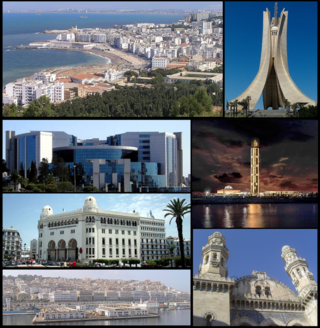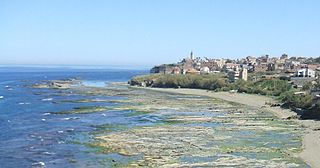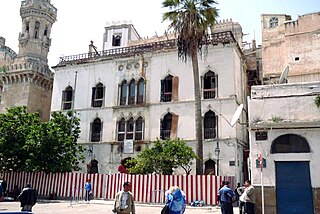
Algiers is the capital and largest city of Algeria, located in the north-central part of the country. The city's population at the 2008 census was 2,988,145 and in 2020 was estimated to be around 4,500,000.

The Casbah is the citadel of Algiers in Algeria and the traditional quarter clustered around it. In 1992, the United Nations Educational, Scientific and Cultural Organization (UNESCO) proclaimed Kasbah of Algiers a World Cultural Heritage Site, as "There are the remains of the citadel, old mosques and Ottoman-style palaces as well as the remains of a traditional urban structure associated with a deep-rooted sense of community."

Dellys is a small Mediterranean town in northern Algeria's coastal Boumerdès Province, almost due north of Tizi-Ouzou and just east of the Sebaou River. It is the district seat of the daïra of Dellys. The town is 45 km from Tizi Ouzou, 50 km from Boumerdes, and about 100 km from the capital Algiers.

Algiers Province is a province (wilayah) in Algeria, named after its capital, Algiers, which is also the national capital. It is adopted from the old French department of Algiers and has a population of about 8 million. It is the most densely populated province of Algeria, and also the smallest by area.

Djamaa el Kebir, also known as the Great Mosque of Algiers, is a historic mosque in Algiers, Algeria. It is located within the Casbah, near the city's harbor. Dating to 1097, it is one of the few remaining examples of Almoravid architecture, although it has undergone other additions and reconstructions since its foundation. It is the oldest mosque in Algiers and is said to be one of the oldest mosques in Algeria after Sidi Okba Mosque and Sidi Ghanem Mosque.

Algeria is the largest country in Africa; one of the main tourist attractions is the Sahara, the largest desert in the world. Algeria has been a member of the World Tourism Organization since 1976. According to a report of the World Tourism Organization published in 2014, Algeria was the 4th largest tourist destination in Africa in 2013 with 2.7 million foreign tourists, and ranks 111th on the international tourism scene, according to the London-based World Tourism and Travel Council (WTTC). The tourism sector in Algeria accounts for 3.9% of the volume of exports, 9.5% of the productive investment rate and 8.1% of the gross domestic product.

The Hassan Pasha Mosque, also referred to as the Pasha Mosque or the Grand Mosque, is a mosque located in Oran, Algeria. It was built in 1796 by order of Baba Hassan, Pasha of Algiers, in memory of the expulsion of the Spanish. During the French Invasion of Algiers in 1830, French soldiers would occupy the mosque during their invasion of Algeria as their living-quarters. 5 years after the French Invasion, in 1835, the building was established as a mosque and renovated three decades later. In 1952, the mosque was listed as a historic monument. Since 2010, this historic monument has been closed to the public.

Baron Charles Frédéric Chassériau du Chiron was a Saint Dominican architect and painter, who served as chief architect of the cities of Marseille, Algiers, in Algeria; and Cairo, in Egypt. He is particularly known for having designed the seafront of the city of Algiers.

The National Museum of Fine Arts in Algiers is one of the largest art museums in Africa. Opened to the public since 5 May 1930, it is located in the Hamma district, next to the Hamma test garden.
The following is a timeline of the history of the city of Algiers, Algeria.
Leïla Marouane (born in 1960) is a Tunisian-born French Algerian journalist and creative writer. Leïla Marouane is a pseudonym; her full name is Leyla Zineb Mechentel. She is an author of novels and short fiction which have received a number of awards within the French-language literature community.

Dar Hassan Pacha is an 18th-century palace located in the Casbah of Algiers, Algeria. It was built in 1791 and used to belong to Hassan III Pasha, who signed a treaty with the US September 5, 1795. After 1830, it became the winter residence of the Governor of Algiers, and as a consequence, it was completely remodelled in 1839, when the entrance has been changed and a new façade was created.

Dar Aziza is a 16th-century Moorish palace located in the Casbah of Algiers in Algeria. Today, it houses the National Agency of Archaeology and Protection of Historic Sites and Monuments. Dar Aziza, arguably the most iconic surviving building of its era in Algiers, was part of a large governmental compound known as Janina Palace, which existed before the arrival of Turkish corsairs.

Dar Mustapha Pacha is a Moorish palace, located in the Casbah of Algiers, Algiers, Algeria. It houses the National Museum of Miniatures, Illumination and Calligraphy.

The bombardment of Algiers in 1683 was a French naval operation against the Regency of Algiers during the French-Algerian War 1681–88. It led to the rescue of more than 100 French prisoners, in some cases after decades of captivity, but the great majority of Christian captives in Algiers were not liberated.

Algiers railway station is a train station in the municipality of Kasbah in the state of Algiers, located near the Kasbah of Algiers and the port of Algiers, and many types of trains of different grades depart from it to all parts of Algeria.

Zawiyet Sidi Boumerdassi or Zawiyet Ouled Boumerdès is a zawiya located within Boumerdès Province in Algeria.

Hocine Ziani is an Algerian painter and artist in plastic arts.

The Government Palace, known before 1962 as Gouvernement général, is the office of the Prime Minister of Algeria and a major public building in Algiers. At the time of its inauguration in 1933, with a surface of 33,000 m2, it was the largest administrative building of the entire French state.
The Palace of the Council of the Nation is the home of the Council of the Nation, the upper house of the Algerian Parliament, in Algiers, Algeria. It is located on Boulevard Zighoud-Youcef on the Algiers waterfront.

















